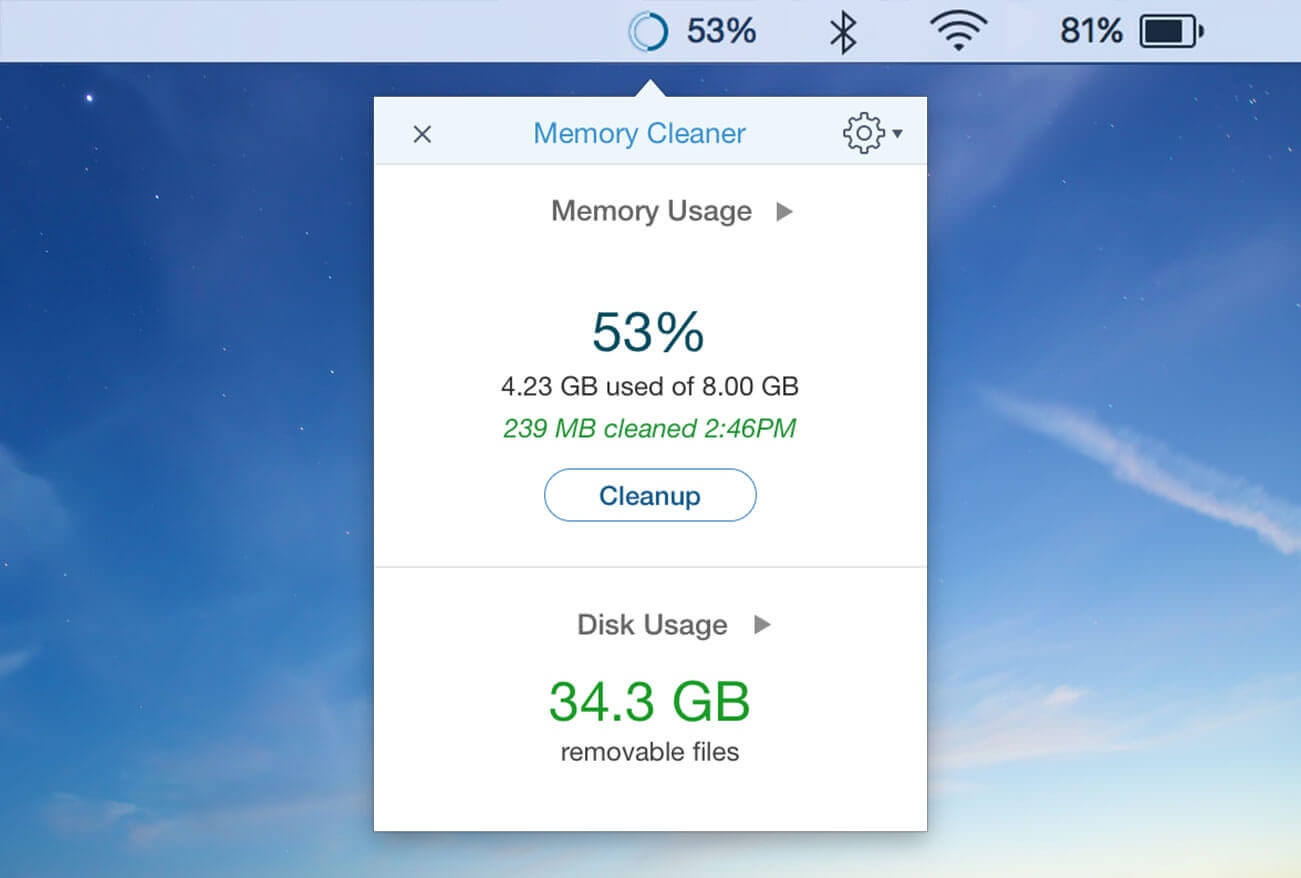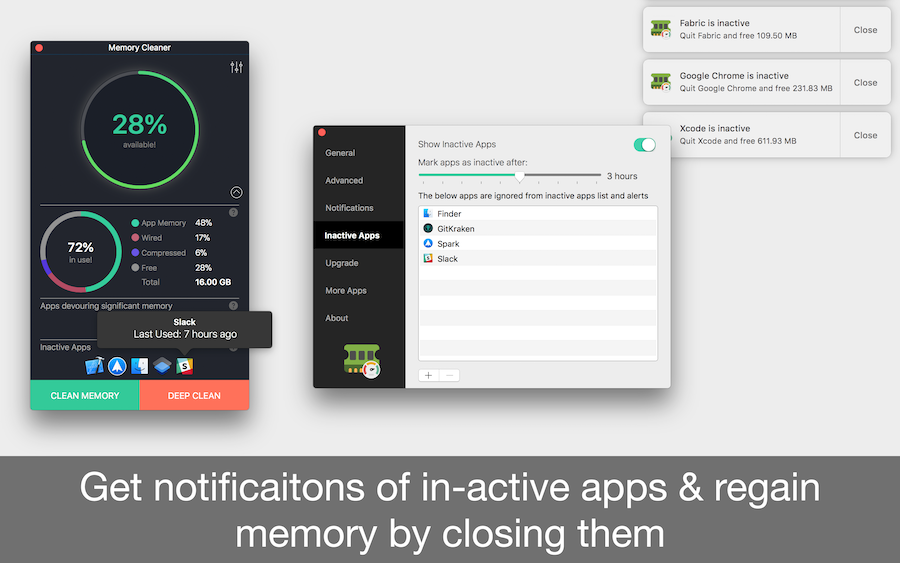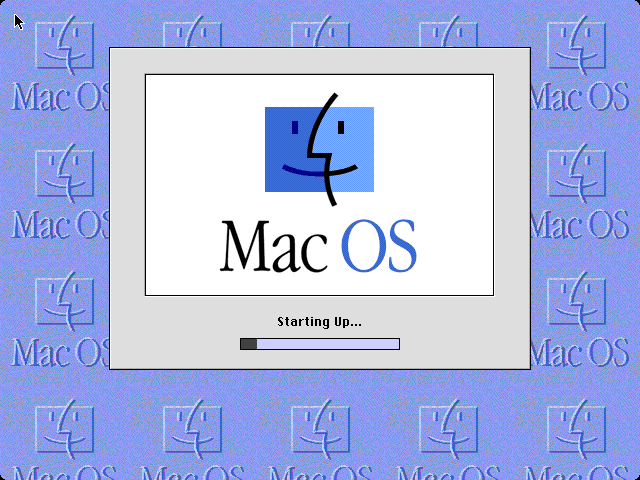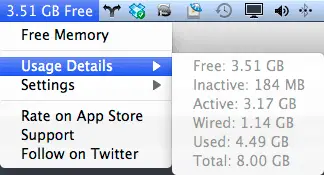On Linux, I often use the free command to see the current amount of free and used memory in the system. For example: $ free total used free shared buffers cached Mem: 729 0 388 -/+ buffers/cache: 4284 Swap: 81264428 It does not seem to exist when I enter free in Mac OS X's Terminal.
Optimized Storage in macOS Sierra and later* can save space by storing your content in iCloud and making it available on demand. When storage space is needed, files, photos, movies, email attachments, and other files that you seldom use are stored in iCloud automatically. Each file stays right where you last saved it, and downloads when you open it. Files that you’ve used recently remain on your Mac, along with optimized versions of your photos.
* If you haven't yet upgraded to macOS Sierra or later, learn about other ways to free up storage space.
Find out how much storage is available on your Mac
Choose Apple menu > About This Mac, then click Storage. Each segment of the bar is an estimate of the storage space used by a category of files. Move your pointer over each segment for more detail.
Click the Manage button to open the Storage Management window, pictured below. This button is available only in macOS Sierra or later.
Manage storage on your Mac
Just click the Clean under memory in the Cleanup section to free up ram Mac instantly. Cleanup will take care of RAM usage of installed processes and apps. However, besides being able to clean Mac and free up memory it can offer a lot of other useful functions. Please enable JavaScript to view the comments powered by Disqus. Jul 12, 2020 How to free up memory on Mac. Knowing how to clear memory on Mac is important, especially if you have a Mac with limited resources. One option is using Activity Monitor: Open Activity Monitor on your Mac; Select an app using a lot of memory; Click the 'x' icon on the top left of the screen; This is straightforward, but there's a better way. Jul 28, 2019 Free memory (was Boost & Memory) is an app to monitor memory and disk space usage and clean up your memory. It increases your Mac’s performance by cleaning cached memory, making more memory available for new apps. The application monitors RAM usage on your computer and frees up unused memory with one click.
The Storage Management window offers recommendations for optimizing your storage. If some recommendations are already turned on, you will see fewer recommendations.
Store in iCloud
Click the Store in iCloud button, then choose from these options:
- Desktop and Documents. Store all files from these two locations in iCloud Drive. When storage space is needed, only the files you recently opened are kept on your Mac, so that you can easily work offline. Files stored only in iCloud show a download icon , which you can double-click to download the original file. Learn more about this feature.
- Photos. Store all original, full-resolution photos and videos in iCloud Photos. When storage space is needed, only space-saving (optimized) versions of photos are kept on your Mac. To download the original photo or video, just open it.
- Messages. Store all messages and attachments in iCloud. When storage space is needed, only the messages and attachments you recently opened are kept on your Mac. Learn more about Messages in iCloud.

Storing files in iCloud uses the storage space in your iCloud storage plan. If you reach or exceed your iCloud storage limit, you can either buy more iCloud storage or make more iCloud storage available. iCloud storage starts at 50GB for $0.99 (USD) a month, and you can purchase additional storage directly from your Apple device. Learn more about prices in your region.
Optimize Storage
Click the Optimize button, then choose from these options.
- Automatically remove watched movies and TV shows. When storage space is needed, movies or TV shows that you purchased from the iTunes Store and already watched are removed from your Mac. Click the download icon next to a movie or TV show to download it again.
- Download only recent attachments. Mail automatically downloads only the attachments that you recently received. You can manually download any attachments at any time by opening the email or attachment, or saving the attachment to your Mac.
- Don't automatically download attachments. Mail downloads an attachment only when you open the email or attachment, or save the attachment to your Mac.
Optimizing storage for movies, TV shows, and email attachments doesn't require iCloud storage space.
Empty Trash Automatically
Empty Trash Automatically permanently deletes files that have been in the Trash for more than 30 days.
Reduce Clutter
Reduce Clutter helps you to identify large files and files you might no longer need. Click the Review Files button, then choose any of the file categories in the sidebar, such as Applications, Documents, Music Creation, or Trash.
You can delete the files in some categories directly from this window. Other categories show the total storage space used by the files in each app. You can then open the app and decide whether to delete files from within it.
Learn how to redownload apps, music, movies, TV shows, and books.
Where to find the settings for each feature
The button for each recommendation in the Storage Management window affects one or more settings in other apps. You can also control those settings directly within each app.
- If you're using macOS Catalina, choose Apple menu > System Preferences, click Apple ID, then select iCloud in the sidebar: Store in iCloud turns on the Optimize Mac Storage setting on the right. Then click Options next to iCloud Drive: Store in iCloud turns on the Desktop & Documents Folders setting. To turn off iCloud Drive entirely, deselect iCloud Drive.
In macOS Mojave or earlier, choose Apple menu > System Preferences, click iCloud, then click Options next to iCloud Drive. Store in iCloud turns on the Desktop & Documents Folders and Optimize Mac Storage settings. - In Photos, choose Photos > Preferences, then click iCloud. Store in iCloud selects iCloud Photos and Optimize Mac Storage.
- In Messages, choose Messages > Preferences, then click iMessage. Store in iCloud selects Enable Messages in iCloud.
- If you're using macOS Catalina, open the Apple TV app, choose TV > Preferences from the menu bar, then click Files. Optimize Storage selects “Automatically delete watched movies and TV shows.”
In macOS Mojave or earlier, open iTunes, choose iTunes > Preferences from the menu bar, then click Advanced. Optimize Storage selects “Automatically delete watched movies and TV shows.” - In Mail, choose Mail > Preferences from the menu bar, then click Accounts. In the Account Information section on the right, Optimize Storage sets the Download Attachments menu to either Recent or None.
Empty Trash Automatically: From the Finder, choose Finder > Preferences, then click Advanced. Empty Trash Automatically selects “Remove items from the Trash after 30 days.”
Other ways that macOS helps automatically save space
With macOS Sierra or later, your Mac automatically takes these additional steps to save storage space:
- Detects duplicate downloads in Safari, keeping only the most recent version of the download
- Reminds you to delete used app installers
- Removes old fonts, languages, and dictionaries that aren't being used
- Clears caches, logs, and other unnecessary data when storage space is needed
How to free up storage space manually
Even without using the Optimized Storage features of Sierra or later, you can take other steps to make more storage space available:
- Music, movies, and other media can use a lot of storage space. Learn how to delete music, movies, and TV shows from your device.
- Delete other files that you no longer need by moving them to the Trash, then emptying the Trash. The Downloads folder is good place to look for files that you might no longer need.
- Move files to an external storage device.
- Compress files.
- Delete unneeded email: In the Mail app, choose Mailbox > Erase Junk Mail. If you no longer need the email in your Trash mailbox, choose Mailbox > Erase Deleted Items.
Learn more
- The Storage pane of About This Mac is the best way to determine the amount of storage space available on your Mac. Disk Utility and other apps might show storage categories such as Not Mounted, VM, Recovery, Other Volumes, Free, or Purgeable. Don't rely on these categories to understand how to free up storage space or how much storage space is available for your data.
- When you duplicate a file on an APFS-formatted volume, that file doesn't use additional storage space on the volume. Deleting a duplicate file frees up only the space required by any data you might have added to the duplicate. If you no longer need any copies of the file, you can recover all of the storage space by deleting both the duplicate and the original file.
- If you're using a pro app and Optimize Mac Storage, learn how to make sure that your projects are always on your Mac and able to access their files.
Clean and Optimize Your Mac to Improve Performance with Outbyte MacRepair
In order to use the program, it needs to be purchased and activated first.
Developed for macOS
See more information about Outbyte and uninstall instructions. Please review EULA and Privacy Policy Outbyte.One of the most common problems that Mac users encounter is low computer memory. Over time, even the most powerful computer will get cluttered with apps, files, extensions , and processes that are too much to handle. To get everything back to normal (because every byte matters), you need to declutter your Mac by cleaning up the mess and removing unnecessary stuff that consumes your computer’s memory.
So when your computer is slowing down, you are likely to notice a “Your system has run out of application memory” message, many of your apps are crashing, or you keep on seeing a lot of spinning rainbow wheels. All these mean your computer is probably low on memory or RAM.

This article will show you how to free up memory on a Mac and other tips to optimize your machine.
What Is RAM?
RAM stands for Random Access Memory and it is one of the most important components of computers and laptops. It is where the computer stores data before being processed. It is a form of volatile memory, where the data is available only when the device is powered on, and everything gets deleted when it is shut down.
Most Macs are equipped with 8GB RAM, but older versions only have 4GB RAM. This is enough if you’re not using RAM-hungry apps, but even then, you’ll still most probably run into memory-related problems in the long run. If you notice that your Mac is taking ages to load or your applications are often crashing, you need to do something to manage your computer’s memory and give it some breathing space.
However, upgrading your Mac’s RAM is more complicated than it sounds. Not all Macs have upgradeable RAM , so you need to check first whether your Mac model has a removable RAM or not. In some models, particularly MacBook Air and MacBook Pro, the RAM is soldered to the board and cannot be replaced.
Free Memory Mac Terminal
Before you think about installing more RAM, you should first try the tips listed below to free up your Mac memory.
How to Free Up RAM on macOS Mojave
There are several things you can do to manage your Mac memory usage and fix any RAM-related problems you are experiencing.
Reboot Your Mac
The first thing you should do when you free up RAM is to restart your Mac. Refreshing the system solves the problem most of the time, especially if the issue was caused by a minor glitch or an app that crashed. Restarting your Mac will delete the data on your RAM and any disk cache, so things should run smoother and faster after rebooting.
However, if you’re in the middle of something and you’re afraid of losing whatever you’re working on, restarting your computer might not be a good idea. If your macOS has hung because you ran out of memory but you don’t want to lose any unsaved information, you might want to try the other solutions below.
Update Your macOS
It is also possible that your memory problem is being caused by a macOS bug or issue. If this is the case, it is important to check whether you are running the latest version of macOS and install any necessary updates.
To check whether there’s an update you need to install, follow the steps below:
- Click the Apple logo and choose App Store under System Preferences.
- Click the Updates tab.
- Install all updates, if there are any.
After installing all the updates, restart your Mac and check whether your RAM problem has been resolved.
Check Memory Usage via Activity Monitor
When your app freezes or your Mac seems to be slower than usual, the first thing you need to check is the Activity Monitor. This is a built-in tool that shows you how much memory is being used, which apps are using it, and how much memory each app or process is hogging. The Activity Monitor will also help you determine if a particular process or app is consuming memory resources more than it should.
When you access the Activity Monitor app, you’ll see complete information regarding each running process or app. You can also add extra data by adding columns on the window.
To launch Activity Monitor, go to Finder > Go > Utilities > Activity Monitor or type in activity monitor in Spotlight. In the Activity Monitor Window, you’ll see a list of processes along with tabs of information regarding those processes, namely CPU, Memory, Energy, Disk, and Network.
Click on the Memory tab to understand how your memory is actually being used by your apps and processes. At the bottom of the window, you’ll see a graph on Memory Pressure and information regarding Physical Memory, Memory Used, Cached Files , and Swap Used. On the rightmost side of the graph, you’ll see data for App Memory, Wired Memory, and Compressed.
The Memory Pressure graph shows how much pressure your computer’s RAM is currently under. Ideally, the graph should be green, which indicates low pressure for your memory. A yellow graph means that you are short of memory while a red graph indicates a critical situation for your RAM, at which point you need to free up some space as soon as possible.
Free Memory For Mac Os
Follow the instructions below to free up some of your RAM using Activity Monitor:
- Launch Activity Monitor and click on the Memory tab.
- Click on the Memory column to arrange the processes according to their memory usage. Make sure that the processes are sorted out from the highest to the lowest.
- If you think that an app is consuming more than its share of memory resources, you can easily kill the process by clicking on the Quit button. Take note, however, that this does not necessarily kill the app. If the process you killed is a webpage, it will just close and reload that page without closing the browser. But if you closed a specific app, you’ll usually see a “closed unexpectedly” warning.

Warning: Don’t close processes that you are not familiar with because they may be related to other important processes on your computer.
Close Unnecessary Apps
Some Mac users are guilty of clicking the close button and thinking that the app is already close d. Note, though, that clicking the close button only closes the window, not the app itself. More often than not, you’re left with several apps still open without you even knowing about it.
Even without looking at the Activity Monitor, you can see which apps are running just by looking at the Dock. If you see a dot below the icon of the app, it means that these apps are still open.
Here’s how to properly close an application and free up some of your memory:
- Right-click the app icon on the Dock.
- Select Quit from the right-click menu.
- Alternatively, you can also choose Quit from the app’s top menu.
Tidy Up Your Files
If you have the habit of saving everything on your Desktop and just leaving them there, then you might want to organize your stuff to lessen the stress on your computer. macOS treats every icon on the Desktop as an active window, so the more items you have on it, the bigger your memory consumption will be.
Delete all unnecessary files and get rid of your junk files using an app such as Tweakbit MacRepair. You can also drag all of them into one folder to make your Desktop neat and tidy.
Delete Cache Files
Deleting cache files will help free up some of your memory, but this is not something a beginner should do. The Cache folder contains some system files that are important for your Mac to run properly, so you should know which files to delete and which ones to keep.
Free Memory Clean For Mac
If you’re confident that you know what you’re doing, you can delete cache files by following these steps:
Mac Free Memory Command
- Click Finder > Go > Go to Folder.
- Type in ~/Library/Caches/ in the dialog box.
- Delete the cache files that you don’t need in the folder, but make sure that you know what files you are deleting.
Clear Inactive Memory via Terminal

Another way to free up your computer’s memory is by purging it using the Terminal. To do this, open the Terminal and type in sudo purge. Hit Enter and type in the admin password. Next, wait as your Mac’s inactive memory is being deleted.
- Edit Your Finder Settings.
If you launch the Finder app and you see either All My Files or Recents, then you might want to change how your Finder app is configured because all the locations of the files shown in that window will be stored in RAM, therefore using up more resources. What you can do is show a specific folder so that only one location will appear.
To do this:
- Launch Finder and go to Preferences.
- Click the General tab.
- Under New Finder windows show , choose a specific folder such as Documents or Desktop.
- Close Finder and relaunch the app.
Free Memory Test Mac
If you have multiple Finder windows open, you can either close those that you don’t need or merge them all together. To merge all open window, click Window from the top menu and click Merge All Windows. This may not save you a huge chunk of memory space, but it helps.
Summary
Free Up Ram Mac
A computer’s memory is a precious commodity that needs to be managed strategically. Since upgrading RAM on Mac computers can be difficult, and sometimes not possible, you can try the methods above to gain back some breathing room for your memory. The trick here is to quit all that you don’t need, delete your junk files, and streamline your processes. Once you do, you’ll definitely notice a huge improvement in your Mac’s performance.
Free Memory Card Recovery Software For Mac
See more information about Outbyte and uninstall instructions. Please review EULA and Privacy Policy Outbyte.